Project Selection Criteria: A Comprehensive Guide to Choosing Winning Projects
In my 20+ years of experience, roughly 70% of projects I’ve encountered didn’t fail during execution – they were doomed from the selection phase. This is why I’m particularly passionate about helping organizations establish robust project selection criteria.
Even with the most apt project management skills you can’t save a poorly chosen project. Project selection criteria plays a key role to select the right project. Let’s make sure you’re selecting the right projects from the start.
This article will equip you to:
- Assess projects using both quantitative and qualitative criteria
- Apply strategic filtering mechanisms to your project portfolio
- Ensure alignment between project selection and organizational goals
- Implement a sustainable project selection framework
What is Project Selection Criteria
Project selection criteria help you evaluate and choose the right project with the help of standard metrics and guidelines. A well-defined selection criteria can be the defining gap between a success story and a costly failure.
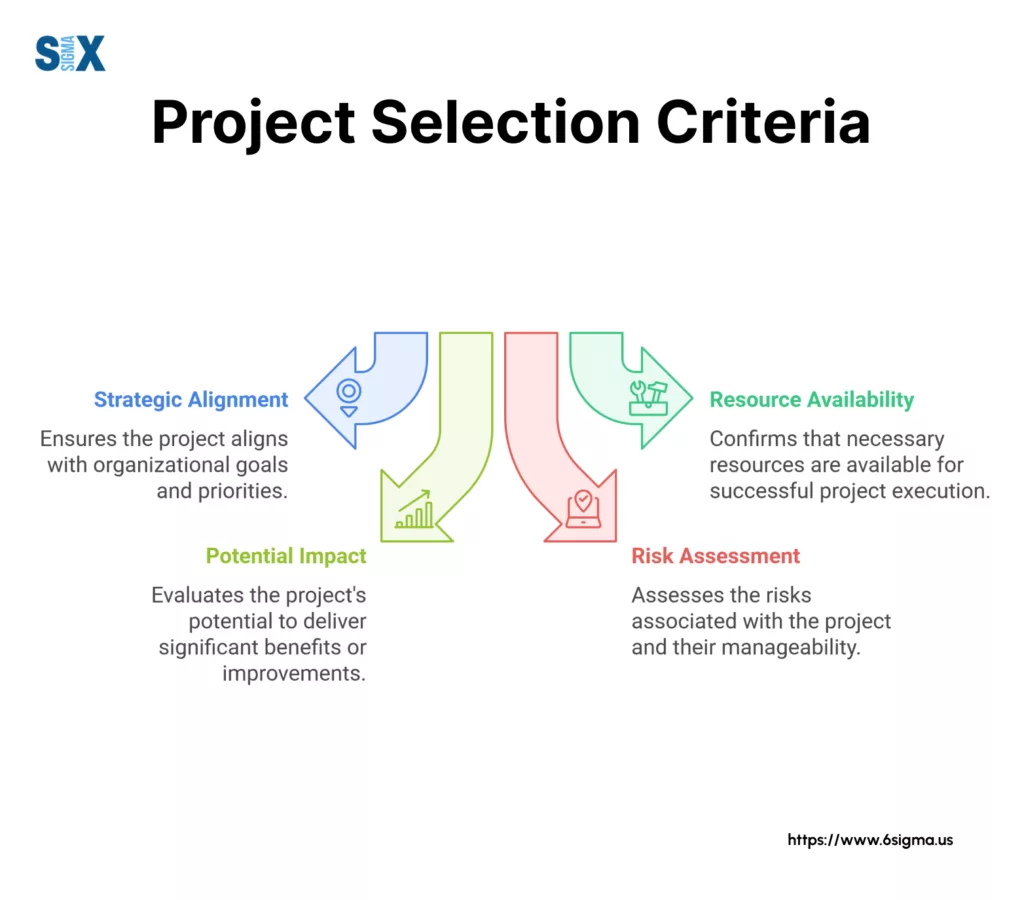
Think of project selection criteria as your organization’s filtering system. These criteria serve as guardrails, ensuring that every project you undertake:
- Aligns with organizational strategy
- Delivers measurable value
- Makes efficient use of available resources
- Has a realistic chance of success
Ready to stop project failures?
Join our Define Phase and Project Selection course teaches you proven methods to identify and prioritize high-impact projects.
Types of Project Selection Criteria
Through my work across different industries, I’ve identified several essential categories of project selection criteria. Here are the most effective ones I’ve implemented:
- Financial Criteria
- Return on Investment (ROI)
- Net Present Value (NPV)
- Payback period
- Cost-benefit ratio
- Strategic Criteria
- Alignment with organizational goals
- Market positioning
- Competitive advantage
- Long-term sustainability
- Operational Criteria
- Resource availability
- Technical feasibility
- Implementation complexity
- Risk assessment
- Stakeholder Criteria
- Customer impact
- Employee engagement
- Regulatory compliance
- Social responsibility
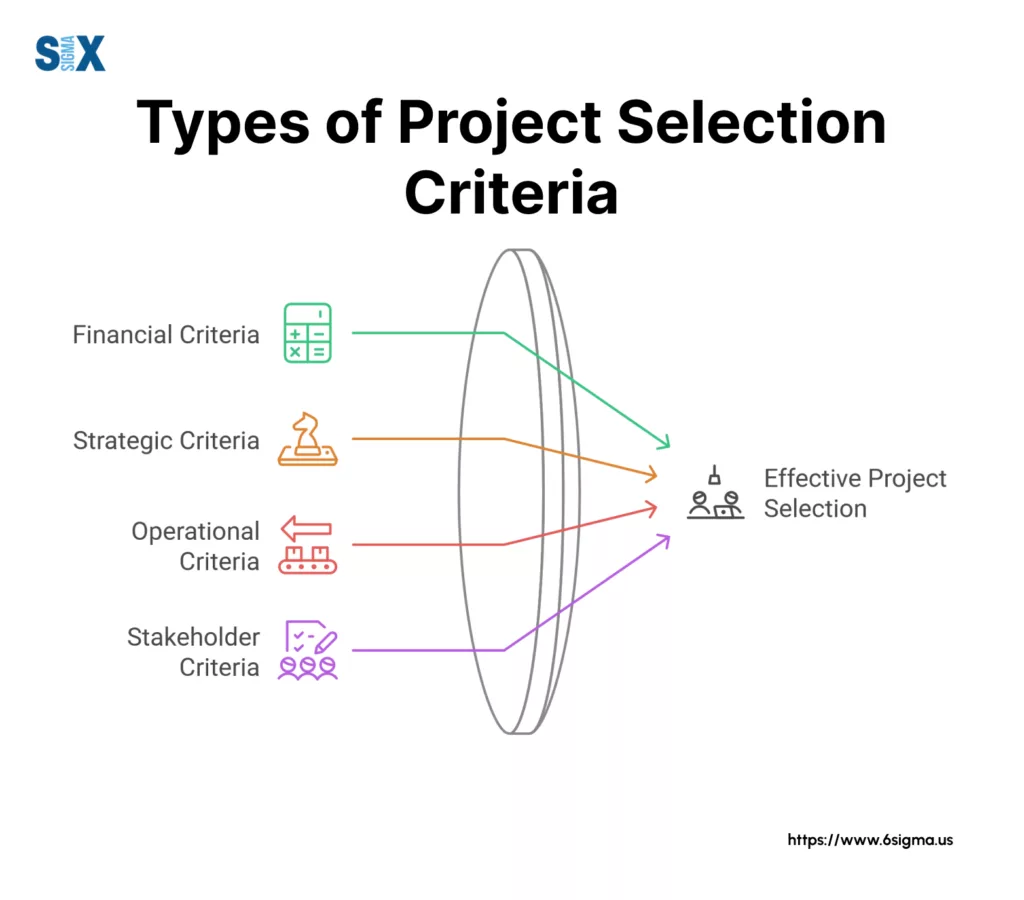
The Role of Project Selection in Project Management
In my experience leading Six Sigma deployments, I’ve observed that project selection is often the most critical phase of project management. It’s where we make the fundamental decisions that impact everything that follows.
The selection process typically involves:
- Executive leadership (setting strategic direction)
- Project Management Office (PMO)
- Department heads and subject matter experts
- Financial analysts
- Key stakeholders
Most successful organizations treat project selection as a collaborative process. Implementing a selection committee structure brings together diverse perspectives, leading to more balanced decision-making.
Tip: One crucial insight is to not keep project selection criteria static. During a project, we regularly reviewed and updated our criteria based on:
- Changing market conditions
- Technological advancements
- Organizational capacity
- Lessons learned from previous projects
This dynamic approach to project selection criteria has consistently proven more effective than rigid frameworks. Remember, “The best selection criteria evolve with your organization’s maturity and market demands”.
Key Project Selection Methods
Project selection methods evolve dramatically. The most effective approaches include some cutting-edge developments that are reshaping how we choose projects.
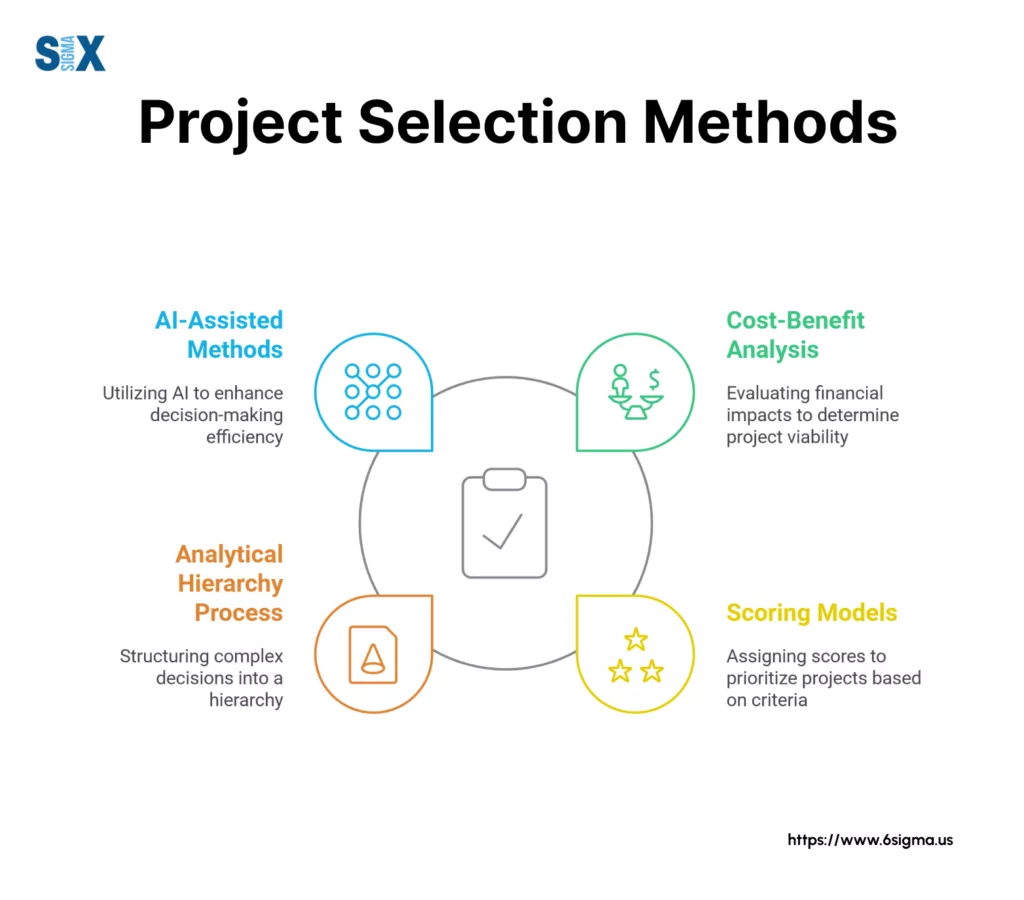
Cost-Benefit Analysis
The cost-benefit analysis remains one of the most reliable project selection methods I’ve used throughout my career. Refine this approach to include both quantitative and qualitative factors.
Here’s a practical example from my consulting work:
When helping a manufacturing client evaluate a new automation project, we analyzed:
- Initial investment: $2.5M
- Annual labor savings: $800K
- Quality improvement savings: $400K
- Maintenance costs: $150K/year
- Training requirements: $100K
The ROI calculation showed a 3-year payback period, but we also considered intangible benefits like improved employee satisfaction and reduced safety risks. I’ve found that successful cost-benefit analyses must look beyond pure numbers.
Scoring Models
In our workshops, I often emphasize that scoring models are particularly effective for comparing dissimilar projects.
Step-by-Step Guide to Creating a Scoring Model:
- Identify key criteria (strategic alignment, risk, resource requirements)
- Assign weights to each criterion (typically 1-5)
- Develop scoring scales (1-10) for each criterion
- Create evaluation matrices
- Calculate weighted scores
Analytical Hierarchy Process (AHP)
The AHP method has been particularly valuable in complex decision-making scenarios. During a project, we used AHP to prioritize R&D projects, resulting in a 40% improvement in project success rates.
Case Study: Technology Investment at a technology company
We used AHP to evaluate competing infrastructure projects:
- Criteria: Technical feasibility, market potential, resource availability
- Alternatives: Three different technology platforms
- Outcome: Selected project delivered 25% higher ROI than the historical average
Emerging Trends: AI-Assisted Selection Methods
Having worked with cutting-edge technologies throughout my career, I’m particularly excited about AI’s role in project selection.
Key AI Applications in Project Selection:
- Predictive analytics for project success probability
- Pattern recognition in historical project data
- Risk assessment automation
- Resource optimization algorithms
However, I always caution my clients that AI should complement, not replace, human judgment. The most effective approach I’ve found is a hybrid model that combines:
- AI-driven data analysis
- Traditional selection methods
- Expert judgment
- Stakeholder input
Pro Tip: When implementing AI-assisted methods, start with a pilot program focusing on smaller, less critical projects to build confidence in the system.
The Project Selection Process
Having led countless Six Sigma deployments across organizations, I’ve learned that a structured project selection process is crucial for success.
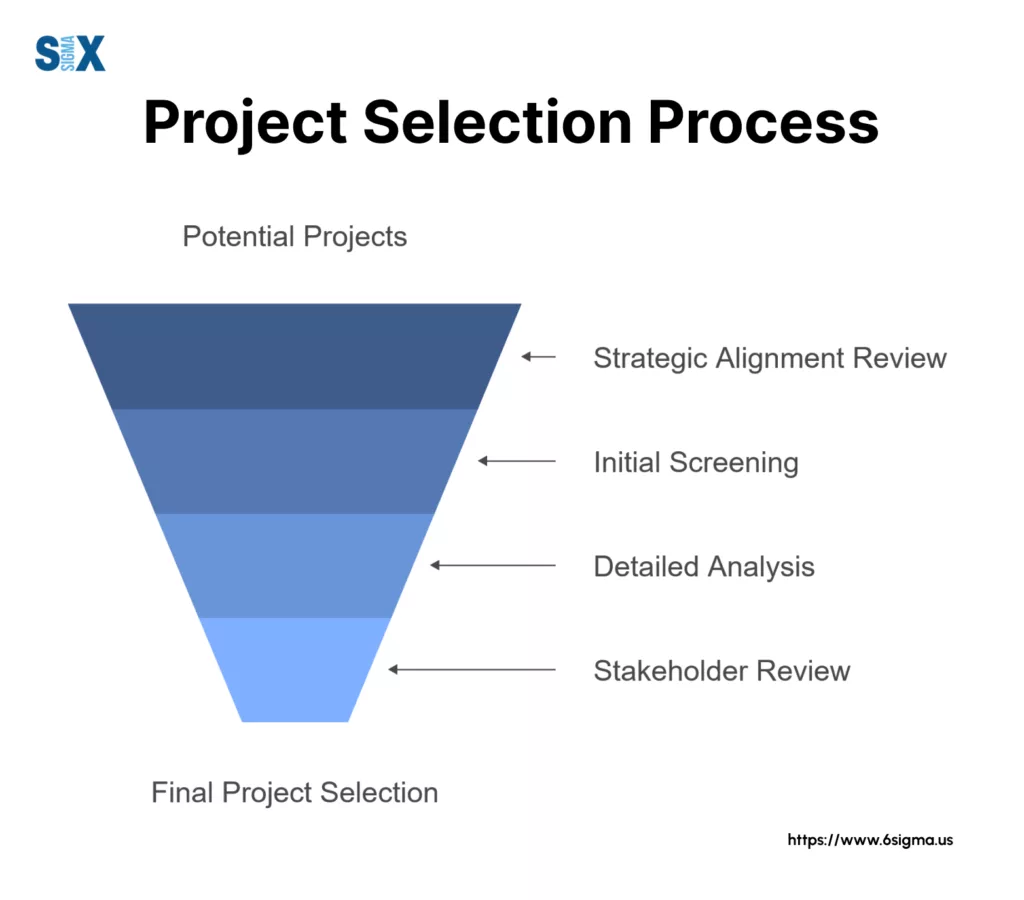
Step-by-Step Guide
- Strategic Alignment Review (1-2 weeks)
- Map potential projects against organizational goals
- Evaluate market conditions and competitive landscape
- Assess technological readiness
- Initial Screening (1 week)
- Apply basic feasibility filters
- Check resource availability
- Verify preliminary business case
- Detailed Analysis (2-3 weeks)
- Conduct comprehensive cost-benefit analysis
- Perform risk assessment
- Evaluate technical requirements
- Stakeholder Review (1 week)
- Gather feedback from key stakeholders
- Address concerns and objections
- Refine project scope based on input
- Final Selection (1 week)
- Present findings to decision-makers
- Compare against other candidate projects
- Make the final selection decision
Roles and Responsibilities
Clear role definition is critical for effective project selection. Here’s the optimal structure I recommend:
Executive Sponsors:
- Set strategic direction
- Approve final selections
- Allocate resources
- Champion selected projects
Project Managers:
- Develop detailed project proposals
- Conduct feasibility studies
- Coordinate stakeholder input
- Present recommendations
Technical Experts:
- Assess technical feasibility
- Evaluate resource requirements
- Identify potential risks
- Provide specialized input
Stakeholders:
- Offer perspective from their areas
- Identify potential impacts
- Provide operational insights
- Support implementation planning
Common Pitfalls and How to Avoid Them
Through my experience leading international projects, I’ve identified several critical pitfalls that organizations must avoid:
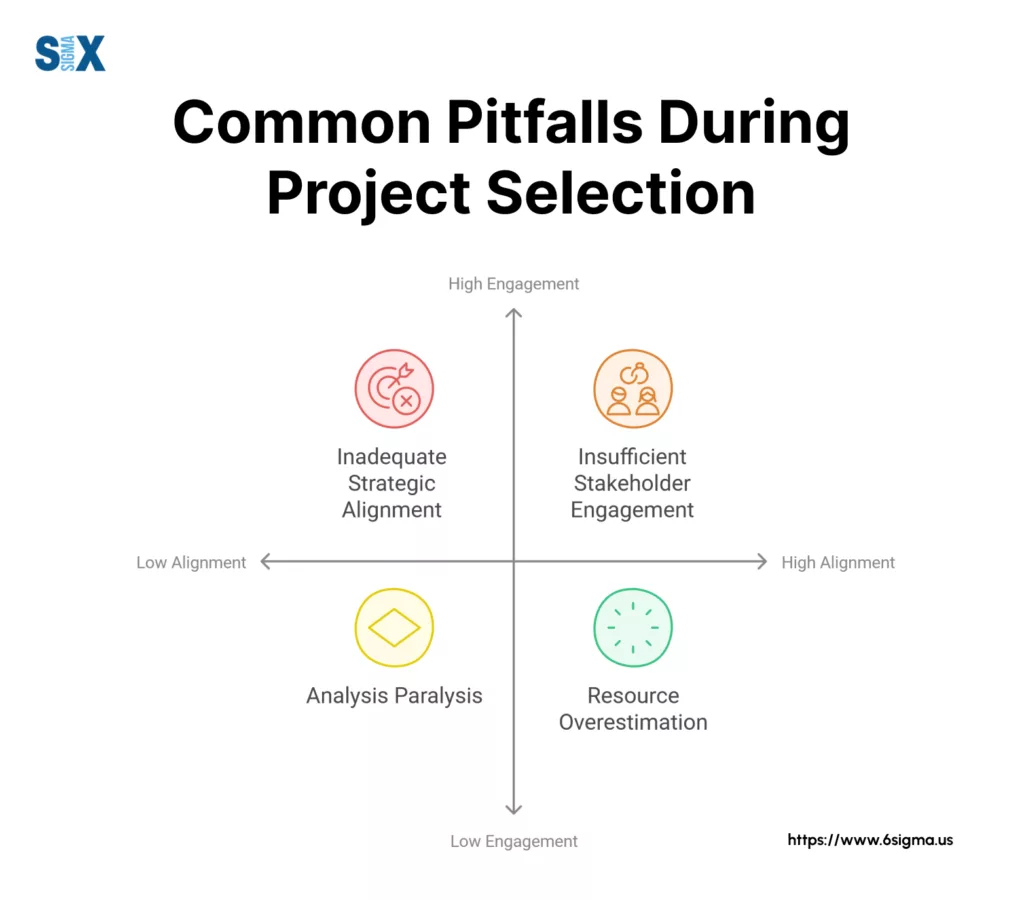
- Inadequate Strategic Alignment
Problem: Selecting projects based solely on financial metrics
Solution: “I always insist on mapping each project to at least two strategic objectives before proceeding with detailed analysis.” - Insufficient Stakeholder Engagement
Problem: Making selections without proper consultation
Solution: Create a structured stakeholder engagement plan early in the process. Implement a stakeholder review board to improve project success rates. - Analysis Paralysis
Problem: Getting stuck in endless evaluation cycles
Solution: “Set firm timelines for each selection phase. I recommend no more than 6-8 weeks total for the entire process.” - Resource Overestimation
Problem: Overcommitting available resources
Solution: Use a capacity-based selection approach. Develop a resource allocation matrix that prevents project overload. - Ignoring Cultural Impact
Problem: Failing to consider organizational readiness
Solution: “Include cultural readiness assessment in your selection criteria. I’ve seen technically sound projects fail simply because the organization wasn’t ready for change.”
Pro Tip: I always tell my workshop participants to maintain a “lessons learned” log during the selection process. This helps refine your project selection criteria over time and improves future decision-making.
Remember, effective project selection is an iterative process. “The goal isn’t to pick perfect projects, but to consistently choose better ones.”
Determining Your Organization’s Selection Criteria
I’ve discovered that successful project selection criteria must be carefully tailored to each organization’s unique context. Let me share how to develop criteria that will drive meaningful results for your specific situation.
Aligning Criteria with Organizational Goals
I’ve developed a strategic alignment framework that consistently delivers results. Here’s my proven approach:
- Strategic Mapping
- Identify core organizational objectives
- Map potential projects to strategic goals
- Quantify alignment strength
- Value Stream Analysis
- Analyze impact on key business processes
- Evaluate potential for breakthrough improvements
- Assess resource optimization opportunities
Industry-Specific Considerations
Project selection criteria must adapt to different industry contexts:
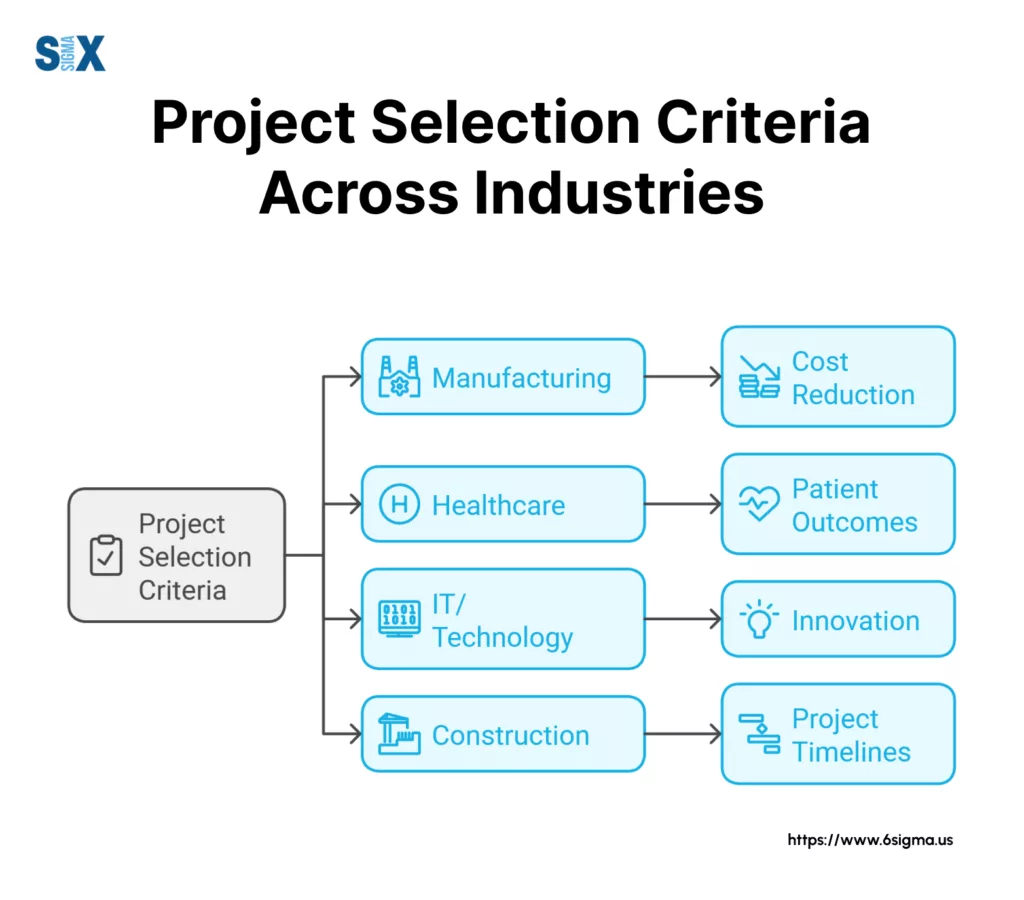
Manufacturing:
- Equipment efficiency improvements
- Quality metrics
- Production capacity
- Waste reduction potential
Healthcare:
- Patient outcomes
- Regulatory compliance
- Staff efficiency
- Risk management
IT/Technology:
- Technical feasibility
- Scalability
- Security requirements
- Integration capabilities
Construction:
- Safety considerations
- Environmental impact
- Timeline feasibility
- Resource availability
Balancing Multiple Criteria
One of the most challenging aspects of project selection is weighing competing criteria. Here’s the prioritization framework I’ve refined through hundreds of international projects:
Primary Considerations:
- Strategic Impact (40%)
- Long-term value creation
- Market positioning
- Competitive advantage
- Resource Requirements (30%)
- Financial investment
- Human capital needs
- Technical resources
- Implementation Feasibility (20%)
- Technical complexity
- Organizational readiness
- Risk factors
- Timing Considerations (10%)
- Market conditions
- Resource availability
- Regulatory requirements
Pro Tip: The best selection criteria are those that evolve with your organization while maintaining alignment with core objectives.
Applying Selection Criteria: Real-World Examples
Let me share some case studies that demonstrate how different organizations adapt these principles to their unique contexts.
Case Study: Tech Startup – CloudSecure Solutions
During my recent consulting work with a cybersecurity startup, I helped implement project selection criteria that balanced innovation with resource constraints.
Initial Situation:
- Limited funding ($2M seed round)
- 15-person technical team
- 3 competing product development initiatives
- 6-month runway to demonstrate market viability
Selection Criteria Applied:
- Market Potential (40%)
- Technical Feasibility (30%)
- Resource Requirements (20%)
- Time to Market (10%)
Outcome:
The startup focused on its endpoint security solution, which:
- Generated $1.5M in first-year revenue
- Secured Series A funding within 8 months
- Achieved 94% customer retention rate
Key Lesson: “For startups, I always emphasize that time-to-market and resource efficiency must carry more weight in selection criteria than they might in larger organizations”.
Case Study: Large Corporation – Manufacturing Giant
We implemented a more complex selection framework for their $50M annual improvement portfolio.
Initial Situation:
- Multiple business units
- Global operations
- 200+ potential projects
- $50M annual improvement budget
Selection Criteria Framework:
- Strategic Alignment (30%)
- Business unit priorities
- Global initiatives
- Market positioning
- Financial Impact (25%)
- ROI projections
- Resource requirements
- Risk assessment
- Operational Excellence (25%)
- Process improvement potential
- Quality impact
- Efficiency gains
- Implementation Complexity (20%)
- Technical requirements
- Change management needs
- Resource availability
Outcome:
- 40% improvement in project success rate
- 25% reduction in project implementation time
- $75M in validated savings within 18 months
Test Scenario
Let’s work through a practical scenario:
Situation:
You’re the project selection committee lead for a medical device manufacturer. You have three potential projects:
Project A: Automated Quality Inspection
- Cost: $2.5M
- Expected ROI: 200%
- Implementation time: 12 months
- Risk level: Medium
Project B: Supply Chain Optimization
- Cost: $1.5M
- Expected ROI: 150%
- Implementation time: 6 months
- Risk level: Low
Project C: New Product Development
- Cost: $3M
- Expected ROI: 300%
- Implementation time: 18 months
- Risk level: High
Key Considerations:
- How do you weigh different criteria?
- What additional information would you need?
- How would your decision change under different market conditions?
Pro Tip: In my experience, the best decisions come from balancing quantitative metrics with qualitative factors like organizational readiness and market timing.
Measuring the Success of Your Selection Process
Measuring the effectiveness of your selection process is crucial for long-term success. Here are some essential KPIs for evaluating project selection effectiveness:
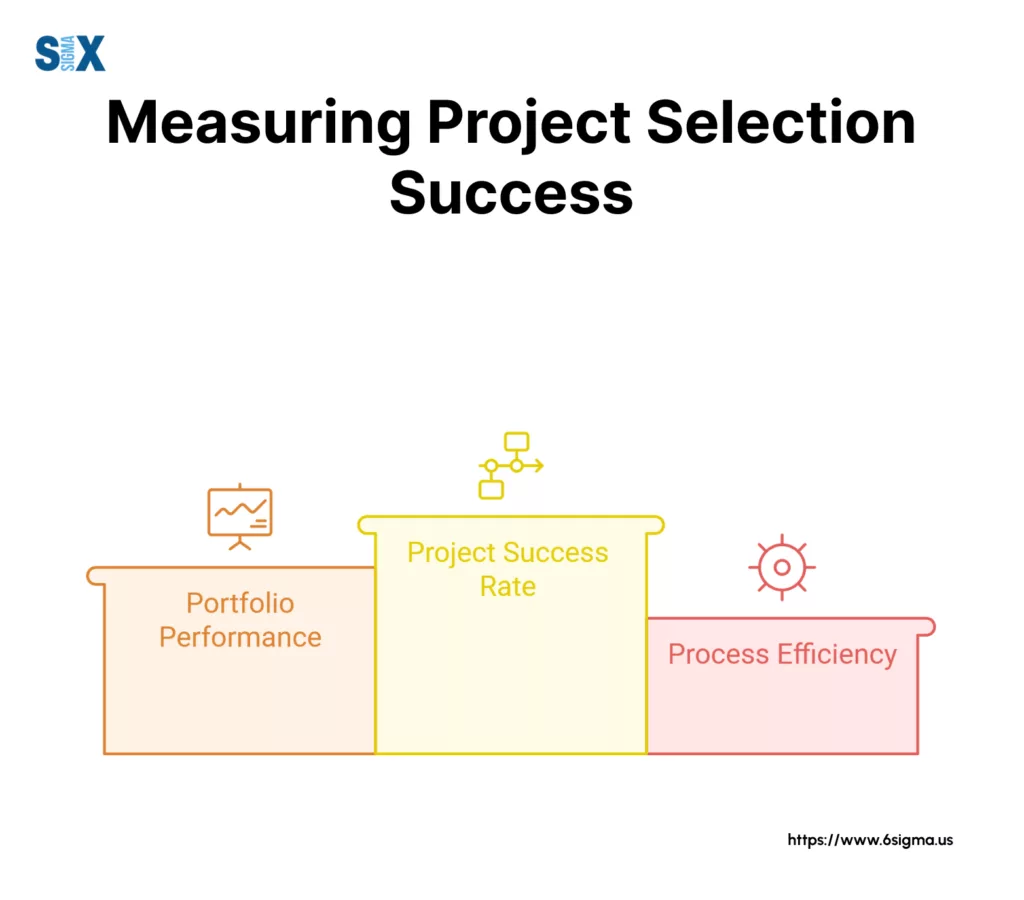
- Project Success Rate
- Percentage of projects meeting objectives
- ROI achievement rate
- Timeline adherence
- Budget compliance
- Portfolio Performance
- Overall portfolio ROI
- Resource utilization efficiency
- Strategic alignment score
- Risk-adjusted return
- Process Efficiency
- Selection cycle time
- Resource allocation accuracy
- Stakeholder satisfaction ratings
- Decision quality metrics
Pro Tip: “Don’t just track the metrics – analyze the patterns. During my time at a telecommunications and electronic systems manufacturer , we discovered that projects with high strategic alignment scores were 3x more likely to succeed, regardless of their initial ROI projections”.
Continuous Improvement
Through my years of consulting, I’ve developed a simple yet effective framework for refining project selection criteria:
The RADAR Improvement Cycle:
- Review: Quarterly analysis of selection outcomes
- Analyze: Identify patterns and correlations
- Develop: Create improvement strategies
- Apply: Implement refined criteria
- Repeat: Continue the cycle
Key Strategies for Continuous Improvement:
- Regular Performance Reviews
- Monthly portfolio assessments
- Quarterly selection process audits
- Annual strategic alignment checks
- Feedback Collection
- Project team surveys
- Stakeholder interviews
- Post-project evaluations
- Executive feedback sessions
Implementation Tips:
- Start with basic metrics and expand gradually
- Focus on leading indicators
- Maintain consistent measurement methods
- Document lessons learned
Conclusion
I can confidently say that your project selection process is the foundation of organizational success. The frameworks, methods, and insights we’ve explored aren’t just theoretical concepts – they’re battle-tested approaches that have delivered billions in value.
Remember, effective project selection criteria aren’t static – they should evolve with your organization’s needs and market conditions. Whether you’re leading a startup or managing a portfolio at a Fortune 500 company, the principles we’ve discussed can be adapted to your specific context.
To develop your skills in project selection, join our short course. Let’s turn your project selection process into a competitive advantage!
SixSigma.us offers both Live Virtual classes as well as Online Self-Paced training. Most option includes access to the same great Master Black Belt instructors that teach our World Class in-person sessions. Sign-up today!
Virtual Classroom Training Programs Self-Paced Online Training Programs







